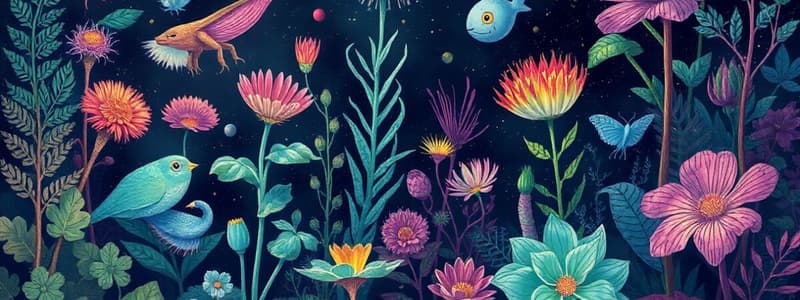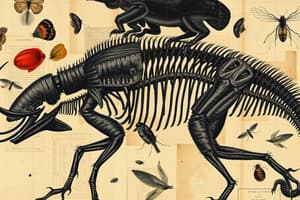Podcast
Questions and Answers
Which of the following characteristics distinguishes plants from animals?
Which of the following characteristics distinguishes plants from animals?
- Plants possess a backbone, whereas animals do not.
- Plants can create their own sustenance through photosynthesis, while animals cannot. (correct)
- Plants are always unicellular, while animals are multicellular.
- Plants are exclusively aquatic, while animals inhabit terrestrial environments.
Considering the classification of organisms, which of the following would be the MOST inclusive group?
Considering the classification of organisms, which of the following would be the MOST inclusive group?
- Multicellular organisms (correct)
- Vertebrates
- Invertebrates
- Animals
If a newly discovered organism is observed to be multicellular and lacks a backbone, how could it be further classified, based on the information provided?
If a newly discovered organism is observed to be multicellular and lacks a backbone, how could it be further classified, based on the information provided?
- Further classification would require information about its method of obtaining food. (correct)
- As a unicellular organism.
- It must be a plant.
- As a vertebrate animal.
A scientist discovers a new single-celled organism. According to the text, how should this organism be classified?
A scientist discovers a new single-celled organism. According to the text, how should this organism be classified?
An organism is identified as a vertebrate. What characteristic MUST it possess?
An organism is identified as a vertebrate. What characteristic MUST it possess?
Flashcards
Organisms
Organisms
Living systems made of smaller parts that work together.
Unicellular Organism
Unicellular Organism
An organism made up of only one cell.
Multicellular Organism
Multicellular Organism
An organism composed of many cells working together.
Vertebrates
Vertebrates
Signup and view all the flashcards
Invertebrates
Invertebrates
Signup and view all the flashcards
Study Notes
Classifying Organisms
- Organisms are living systems with parts working together
- Unicellular organisms are made of one cell. They are very small and need a microscope to see.
- Multicellular organisms have more than one cell. Most organisms we see every day are multicellular.
- Scientists classify organisms by their characteristics into smaller groups like plants, animals, fungi, protists, and bacteria.
Plants
- Plants are multicellular organisms
- Examples include trees, grasses, flowers, bushes, vines, mosses, and herbs
- Plants can make their own food through photosynthesis.
- Water lilies and Elodea are examples of plants that live in water.
Animals
- Animals are multicellular organisms
- Animals are further divided into vertebrates and invertebrates
- Vertebrates have a backbone (examples: moose, salmon, blue jay)
- Invertebrates do not have a backbone (examples: spider, shrimp, snail).
- There are more types of invertebrates than vertebrates.
Studying That Suits You
Use AI to generate personalized quizzes and flashcards to suit your learning preferences.




